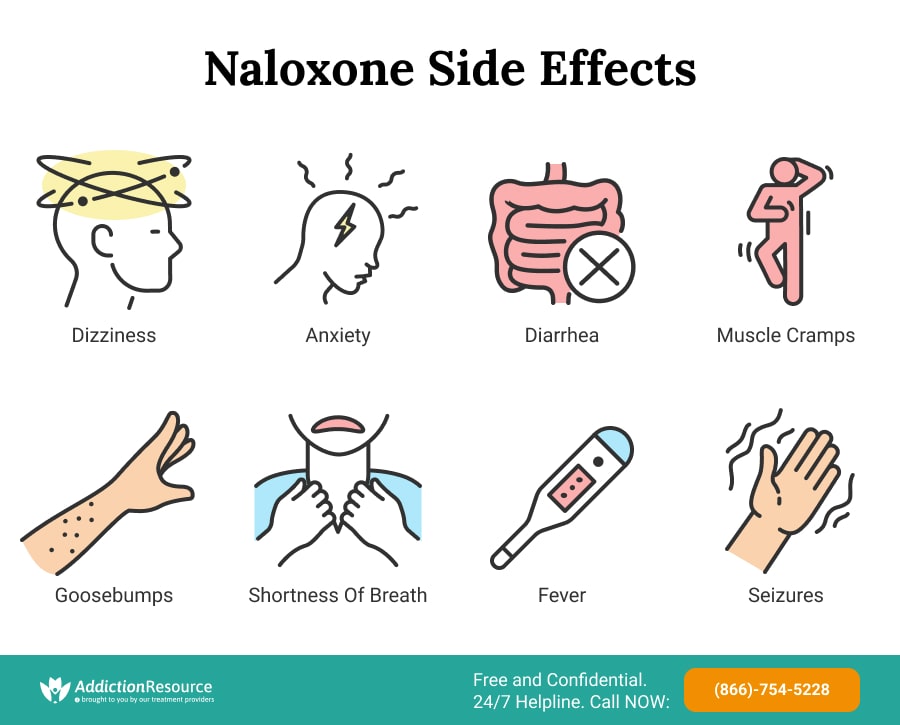
Naloxone is an incredibly effective and potentially life-saving drug. Yet, it comes bundled together with a variety of negative symptoms. The adverse effects of Narcan can even deter people from keeping the medicine in their first-aid kit. While there are situations when a patient doesn’t need Narcan, it is vital to have detailed information about when naloxone side effects are negligible compared to its immediate benefits. The FDA is a reliable source of this type of health information.
Table Of Contents:
- What Are the Сommon Side Effects of Narcan?
- What Are the Rare Side Effects of Narcan?
- Is It Safe to Use Naloxone During Pregnancy and Breastfeeding?
- How Does Narcan Affect Non Overdosed People?
- How To Be Aware of Naloxone Side Effects and Further Actions?
- What Happens if Naloxone Is Given to Someone Who Has Overdosed?
- What Precautions Are Needed for Narcan Administration?

Common Side Effects Of Naloxone
According to the Centers For Disease Control and Prevention, from 1996 to 2014, 26463 opioid overdose reversals were recorded due to the use of this medication. These extraordinary results lead many people to wonder what this drug is, how it works, and its side effects. The vast majority of these adverse effects originate in their interaction with opioid drugs. Narcan drug class is opioid drugs antagonists, meaning it rapidly blocks the action of opiates and thus causes severe withdrawal.
The most common adverse effects of Narcan are similar to opioid drugs withdrawal symptoms. They rarely persist, however, since the medication stops acting after approximately an hour after the administration.
These symptoms can include:
- dizziness
- weakness and fatigue
- restlessness and anxiety
- flushing
- irritability
- diarrhea
- muscle cramps
- goosebumps
- shortness of breath
- nausea
- sneezing
- chills
- fever
- stomach pain

Rare Side Effects of Naloxone
More severe Narcan side effects occur rarely and mostly under special circumstances such as a specific route of administration, interaction with other drugs, and a person’s medical conditions that are unrelated to the overdose. For instance, side effects of this drug injection might include inflammation or infection of the injection site, which do not occur when a patient uses its nasal spray. Therefore, you need to know this information.
Severe side effects of naloxone may include:
- seizures
- abnormally high or low blood pressure
- cardiac arrhythmias
- coma
- allergic reaction to this medication

Recent information from health experts shows that its allergy symptoms can indicate a potentially life-threatening situation. A person should call his doctor or health provider immediately once they begin to experience swelling of the lips and tongue, hives, difficulty breathing, or trouble swallowing after this opioid antagonist administration.
Allergic reactions
Narcan contraindications are seen in patients who are hypersensitive to naloxone hydrochloride or any of the other ingredients in the formulation.
Overdose Narcan
Narcan overdose symptoms include respiratory depression (slow, weak breathing) and loss of consciousness. Opioid overdose is a medical emergency because it can sometimes be fatal.
Naloxone and Pregnancy Warnings
The relationship between Naloxone and pregnancy is not studied well enough to rule out the risks. Naloxone pregnancy category is B/C, which indicates that no adverse reactions were recorded during animal studies. Still, no adequate research on humans has been conducted. Narcan can be used by pregnant women in emergencies. During an opioid overdose, a person’s breathing slows or stops, and it can inflict greater damage on the baby than the use of the drug would. In such situations, correct Narcan dosing is crucial to prevent prolonged oxygen deprivation.
At the same time, common Narcan effects include the emergence of opioid withdrawal symptoms that sometimes can be observed in the baby. Opioid withdrawal might also increase the chance of preterm delivery.
The use of Narcan spray during an overdose can save the lives of both the mother and the child. Still, it is advised to consider long-term treatment with medications that contain Narcan with caution.
In every pregnancy, a woman starts out with a 3-5% chance of having a baby with a congenital disability. This is called her background risk. Very little of this drug from buprenorphine/naloxone gets into the blood when taken by mouth. So, very small amounts of the ingested medication are expected to reach the developing baby. There is a limited number of studies on its use during pregnancy. Studies in women taking naloxone during the first trimester did not find an increased chance of congenital disabilities above the background risk in their babies. No studies have been done to see if treatment with naloxone in the first trimester can increase the chance of birth defects.
Studies have been done to see if it causes pregnancy complications when it is used for overdosing treatment in the second or third trimester. Pregnant women who misuse opioids can have a greater chance of pregnancy complications. During an opioid overdose, the woman’s breathing slows down. If a mother is not breathing well, the baby may not get enough oxygen for a while. That can have a harmful effect on the baby’s development. However, this drug helps return breathing to normal. It can also put the mother into withdrawal from the opioid that she was using. The effects of opioid withdrawal while pregnant are not well understood. After treatment with this medication, a woman should let her healthcare providers know about it as soon as possible.
Naloxone Breastfeeding Warnings
It is not clear whether the drug can get into breast milk. However, it’s not orally bioavailable and is only effective as an injection or nasal spray. Therefore, even if an infant ingests the medication with milk, the side effects are highly unlikely to be experienced by the child. Suppose a woman needs Narcan for an opioid overdose. In that case, she should not breastfeed until the opioid drug is gone from her body. If there is an opioid in breastmilk, the baby may be sleepy, have problems with feeding, and have problems breathing. Talk to your healthcare providers about all of your breastfeeding questions and concerns.

What Happens If Narcan Is Given To Someone Who Doesn’t Need It
Naloxone’s mechanism of action allows it to only influence the opioid receptors in the human body. Therefore, the side effects of Narcan, including withdrawal symptoms, will not appear if a person doesn’t have opioids in their system. The medication is not harmful to those who take it without overdosing on opiates. It is also ineffective against non-opioid illicit drugs such as cocaine.
If a person does not take more than the recommended dose of opioids but takes any opioids within an hour after administering this opioid antagonist, they may experience withdrawal symptoms. Narcan will also render opioid pain medications ineffective for the duration of their action. In patients who are not dependent on opioids, the side effects of naloxone are rarely severe and normally disappear quickly. The half-life of Narcan is only 30-60 minutes, meaning that any opioid medications will resume their actions after this time.
Be Aware Of Naloxone Side Effects And Further Actions
Narcan side effects are mainly linked to the interaction between the medication and opioids in a person’s system. Fever, nausea, irritability, and other flu-like symptoms are all among the common side effects. This medication use during pregnancy is recommended if a woman stops breathing when overdosed. Narcan is only an emergency remedy meaning that a patient needs further medical assistance and proper substance abuse treatment. That’s why it is critical to contact professional rehabilitation centers right after its administration to ensure subsequent aid. The risk of an Opioid withdrawal increases with higher doses of Narcan. Those who do not seek medical treatment after receiving a dose of naloxone may face an urge to take more drugs – especially if they are addicted to Opioids. The medication stays in the body for approximately one hour, sometimes a little more. However, some Opioids can stay in the body for up to 12 hours, meaning Narcan will wear off long before the drug. Consuming additional Opioids after taking the medication significantly increases your risk of a second overdose.
What Happens if Naloxone is Given to Someone Who Has Overdosed?
Families with loved ones who have opioid addiction should have this antagonist nearby; ask their family member to carry it, and let friends know where it is. People should still call 911 immediately in the event of an overdose.
Naloxone is being used more by police officers, emergency medical technicians, and non-emergency first responders than before. In most states, people at risk or who know someone at risk for an opioid overdose can be trained on how to give it. Families can ask their pharmacists or health care provider how to use the devices.
According to the FDA policy, having Narcan on hand can save a life during an opioid overdose.
Precautions Needed For Narcan Administration
Naloxone works to reverse an opioid overdose in the body for only 30 to 90 minutes. But many opioids remain in the body longer than that. Because of this, it is possible for a person to still experience the effects of an overdose after a dose of the drug wears off. Also, some opioids are stronger and might require multiple doses. Therefore, you need to be aware of FDA guidelines, and one of the most important steps to take is to call 911 so the individual can receive immediate medical attention. NIDA is supporting research for stronger formulations for use with potent opioids.
People who are given naloxone should be observed constantly until emergency care arrives. They should be monitored for another 2 hours after the last dose was given to make sure breathing does not slow or stop.
People with physical dependence on opioids may have withdrawal symptoms within minutes after they are given a dose of the medication. Withdrawal symptoms might include headaches, changes in blood pressure, rapid heart rate, sweating, nausea, vomiting, and tremors. While symptoms like vomiting are uncomfortable, it is usually not life-threatening. The risk of death for someone overdosing on opioids is worse than the risk of having a bad reaction to naloxone. Clinicians in emergency room settings are being trained to offer patients immediate relief and referral to treatment for opioid use disorder with effective medications after an opioid overdose is reversed. NIDA has a policy and offers tools for emergency clinicians here.
Side effects from this medicine are rare, but people might have allergic reactions to Naloxone. Overall, the medication is a safe medicine. But it only reverses an overdose in people with opioids in their systems. It will not reverse overdoses from other drugs like cocaine or methamphetamine.
There are no Narcan contraindications when used in an emergency. The only relative contraindication is known hypersensitivity to the medication. However, users need to check for nausea and vomiting, which are the common withdrawal symptoms.
Find Drug Rehabilitation Centers Near You Anywhere In the US
Addiction Resource team has compiled an extensive list of the top drug rehabilitation facilities around the country. Use our locator tool to find the best centers near you.
Page Sources
- Medication-Assisted Treatment. Naloxone. https://www.samhsa.gov/medication-assisted-treatment/medications-counseling-related-conditions/naloxone
- NIDA. 2021, June 1. Naloxone DrugFacts. https://www.drugabuse.gov/publications/drugfacts/naloxone
- Jordan MR, Morrison Ponce D. Naloxone. [Updated 2021 Jul 13]. In: StatPearls. Treasure Island (FL): StatPearls Publishing; 2021 Jan. https://www.ncbi.nlm.nih.gov/books/NBK441910/.
- FDA,2019, Drugs, Having Naloxone on Hand Can Save a Life During an Opioid Overdose. https://www.fda.gov/consumers/consumer-updates/having-naloxone-hand-can-save-life-during-opioid-overdose.
- Opioid Overdose Basics. Understanding Naloxone. https://harmreduction.org/issues/overdose-prevention/overview/overdose-basics/understanding-naloxone/


 Reviewed by:
Reviewed by:  Written by:
Written by: 
 FindTreatment.gov
FindTreatment.gov